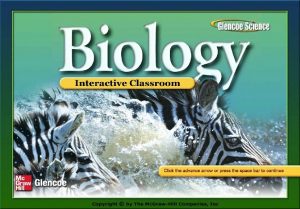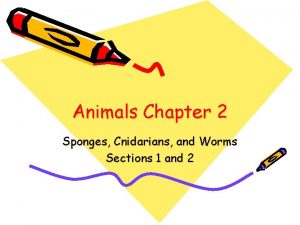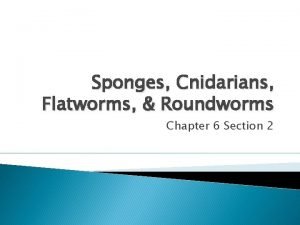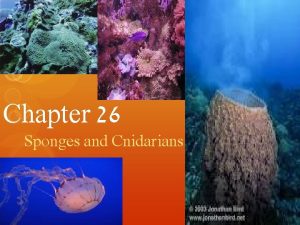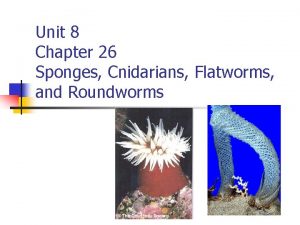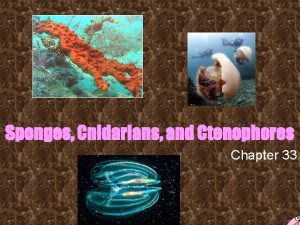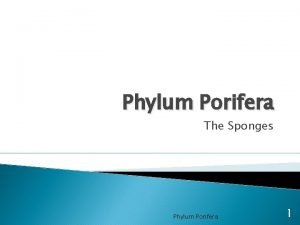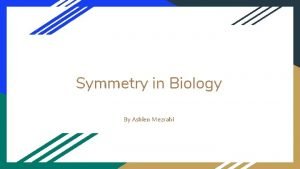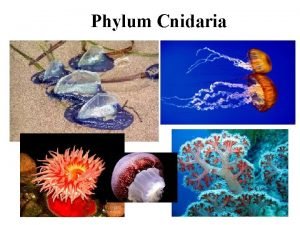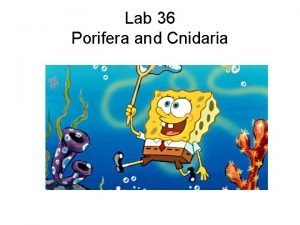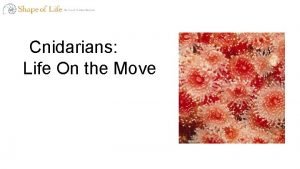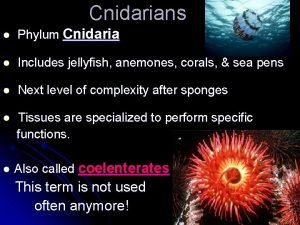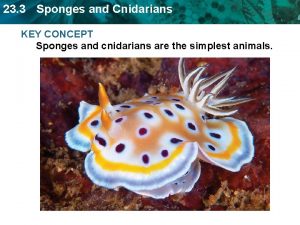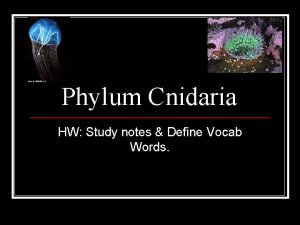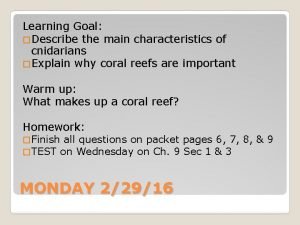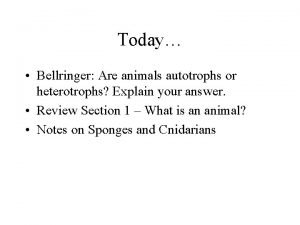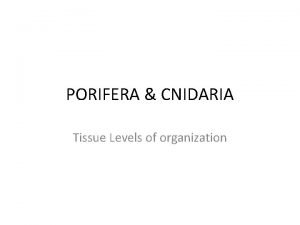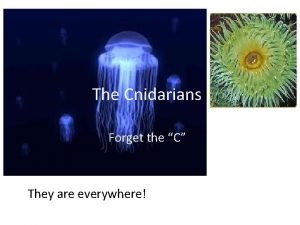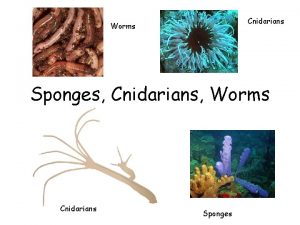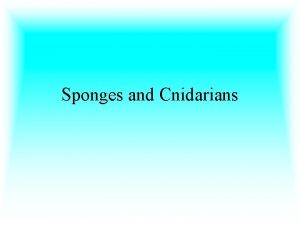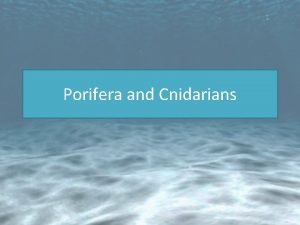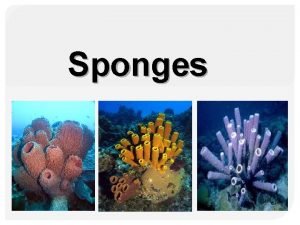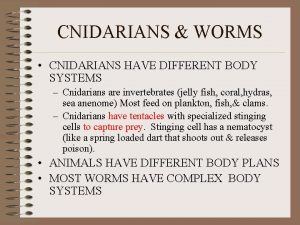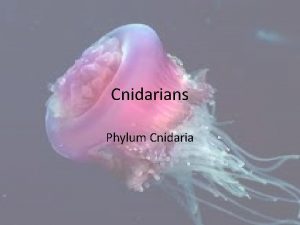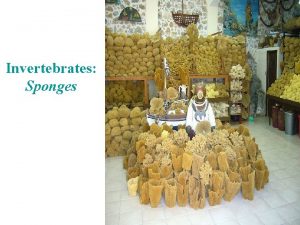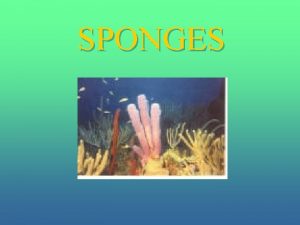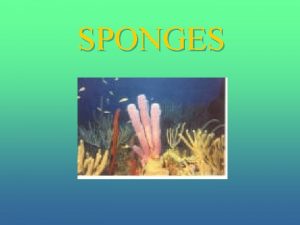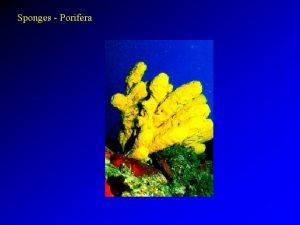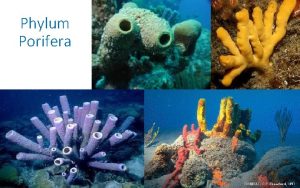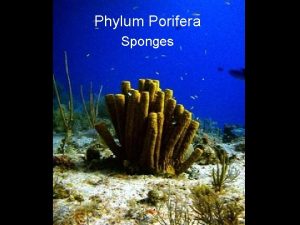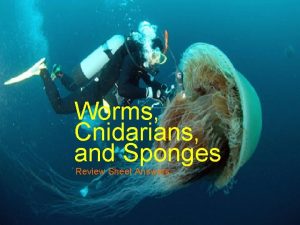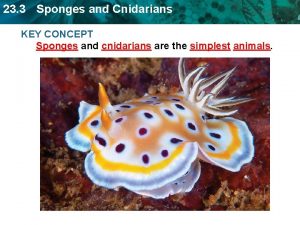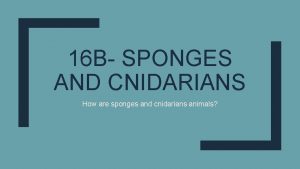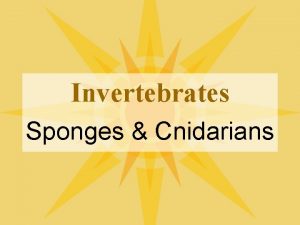Porifera and Cnidarians PORIFERA SPONGES PORIFERA The Sponges






















- Slides: 22

Porifera and Cnidarians PORIFERA: SPONGES

PORIFERA The Sponges



PORIFERA Sac-like body plan Radially symmetrical Sessile Hermaphroditic Not cephalized (no head) Attach to surfaces Porifera means pore-bearing � Incurrent openings through which water enters the sponge – Porocytes Excurrent opening or Osculum � Water exit

PORIFERA STRUCTURE

PORIFERA Constant current of water moving through the sponge – created by the flagella of collar cells New water enters the sponge with food & oxygen and leaves with wastes No circulatory or respiratory systems – rely on diffusion No specialized nervous system Supported by spicules (hard) or spongeon fibers (soft) Reproduction: hermaphroditic broadcasters, regeneration, gemmule formation

CNIDARIANS Jellyfish, Hydra, Sea Anemones http: //www. youtube. com/watch? v=Jo. MCTv. Rkvxo&feat ure=fvw

PHYLUM: CNIDARIA

GENERAL CHARACTERISTICS “soft” bodied animals with tentacles surrounding mouth Few cell layers thick Radial symmetry All have stinging cells call nematocysts (or cnidoblasts) Sac-like body Endoderm, Mesoglea, Ectoderm

CNIDOBLASTS/NEMATOCYSTS Each cnidoblast has a capsule called a nematocyst on the tentacle which contains a long coiled thread When triggered, the nematocysts are discharged Nematocysts are filled with poison and used to capture and eat prey Some threads kill prey, others inject paralyzing toxins


BODY FORMS Polyp � Mouth at top � Sessile Medusa � Mouth � Motile at bottom

In some species, one form is dominant, while the other is reduced (short-lived) In other species, only one form is present and the other not present at all

REPRODUCTION Sexual and asexual Medusa produces sperm and eggs into the water If no medusa form is present (eg hydra) an ovary or testi develops in the polyp body wall Asexual by fragmentation and budding (polyp)

REPRODUCTION Fertilization occurs in open water or inside an eggcarrying medusa � Zygote – ciliated larva that attach to a surface and become a polyp Some are hermaphrodites, others are either male or female



MOVEMENT Lack muscle tissues that most animals have to move Muscle fibres and nerve fibres are present Cnidarians are capable of directional movement The body can expand or shrink

FEEDING Tenticles that surround the mouth can reach out and grasp prey Gastrovascular cavity carries out digestion and distributes food and gases Nutrient molecules are passed by diffusion to other body cells

RESPONSE No brain, but have a simple system – nerve nets Sensory cells in the epidermal layer detect chemicals from food and touch foreign objects

CLASSIFICATION Hydrozoans � Exist mostly as polyp � Eg. Hydra Schyphozoans � Exist mostly as medusa � Eg. Jellyfish Anthozoans � Sessile polyps � Eg. Anemones, coral forming cnidarians
 Chapter 24 body plans of animals with bilateral symmetry
Chapter 24 body plans of animals with bilateral symmetry Sponges cnidarians and worms
Sponges cnidarians and worms Chapter 26 sponges and cnidarians answer key
Chapter 26 sponges and cnidarians answer key Chapter 26 sponges and cnidarians answer key
Chapter 26 sponges and cnidarians answer key Sponges
Sponges Section 33-2 review cnidaria and ctenophora answer key
Section 33-2 review cnidaria and ctenophora answer key Sponges and cnidarians video
Sponges and cnidarians video Gambar struktur porifera
Gambar struktur porifera Symmetry of cnidarians
Symmetry of cnidarians Ctenophora vs cnidaria
Ctenophora vs cnidaria Cnidaria body plan
Cnidaria body plan Sponges types
Sponges types Cnidarians life on the move
Cnidarians life on the move Two body forms of cnidarians
Two body forms of cnidarians 2 body forms of cnidarians
2 body forms of cnidarians Define cnidocytes
Define cnidocytes What are characteristics of cnidarians
What are characteristics of cnidarians Cnidocytes jellyfish
Cnidocytes jellyfish Are sponges autotrophs or heterotrophs
Are sponges autotrophs or heterotrophs Porifera and cnidaria
Porifera and cnidaria Cnidaria tissue layers
Cnidaria tissue layers Hát kết hợp bộ gõ cơ thể
Hát kết hợp bộ gõ cơ thể Slidetodoc
Slidetodoc
